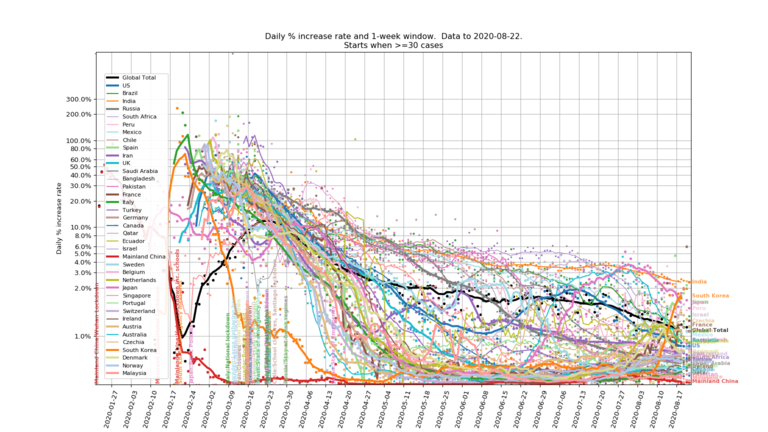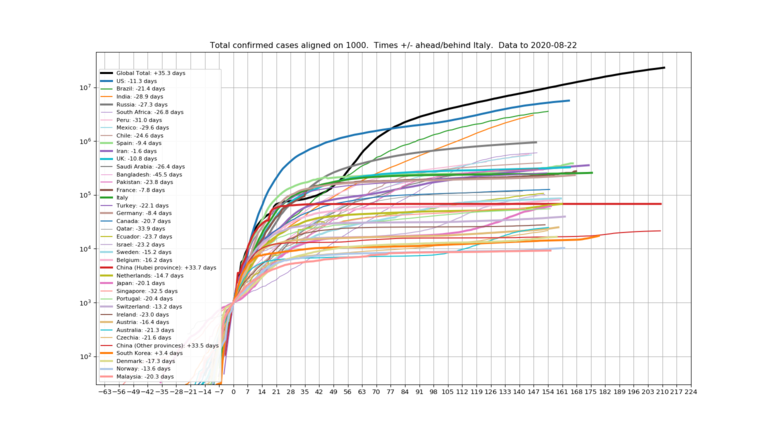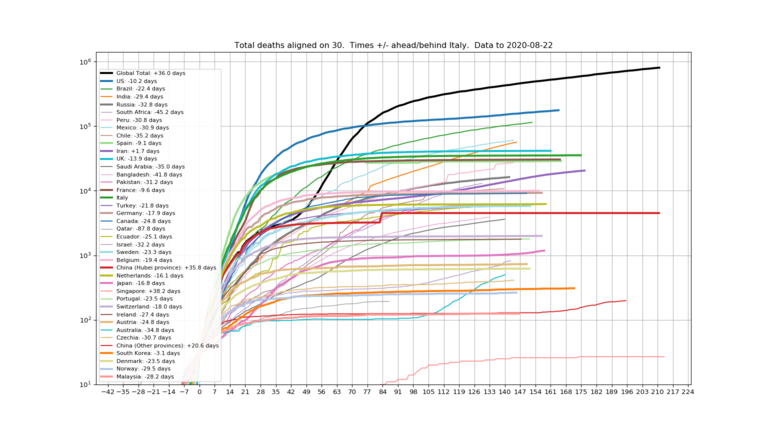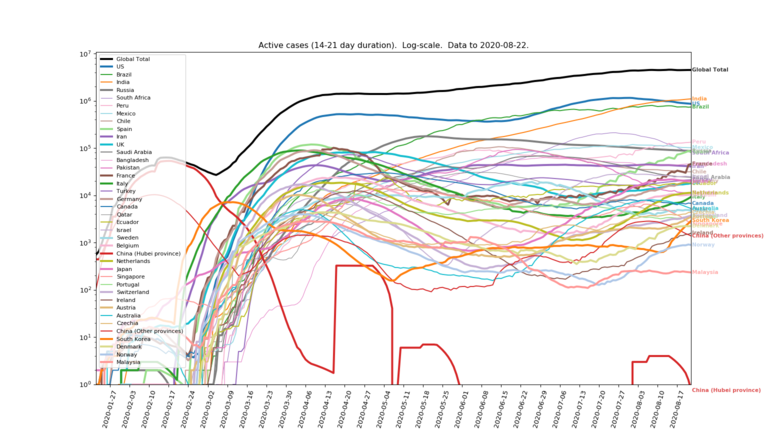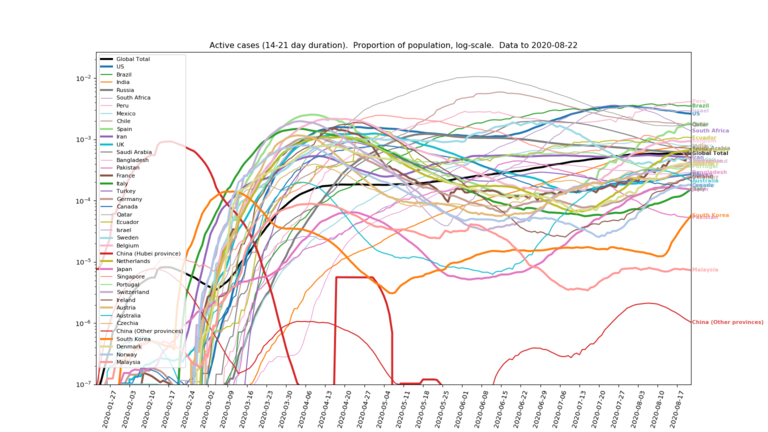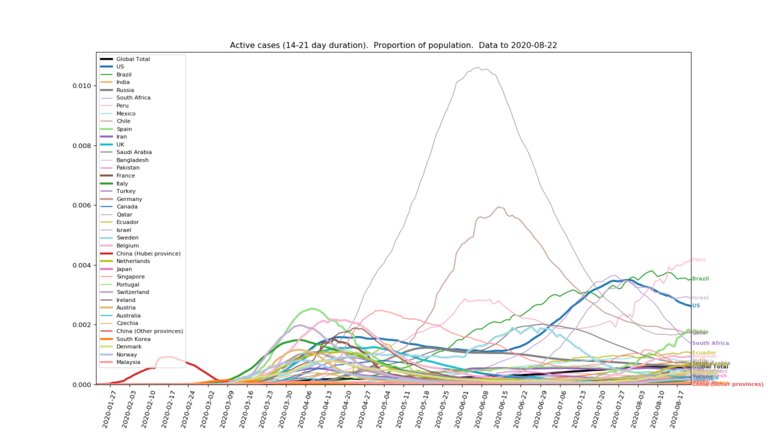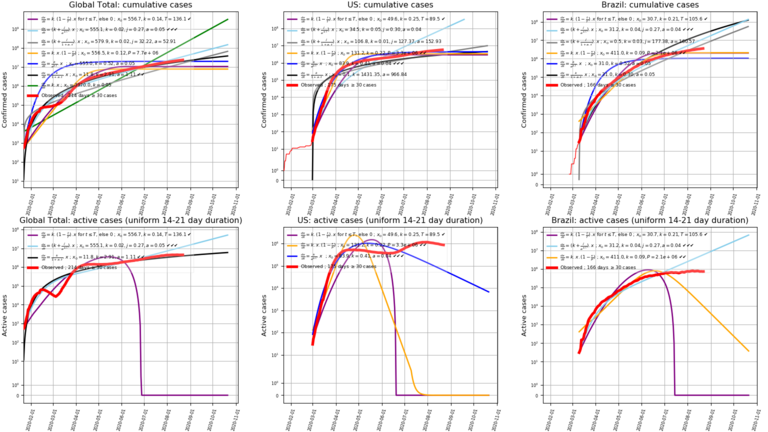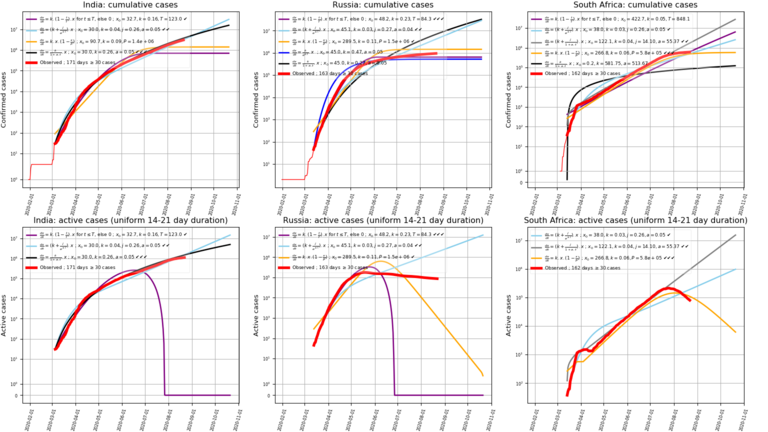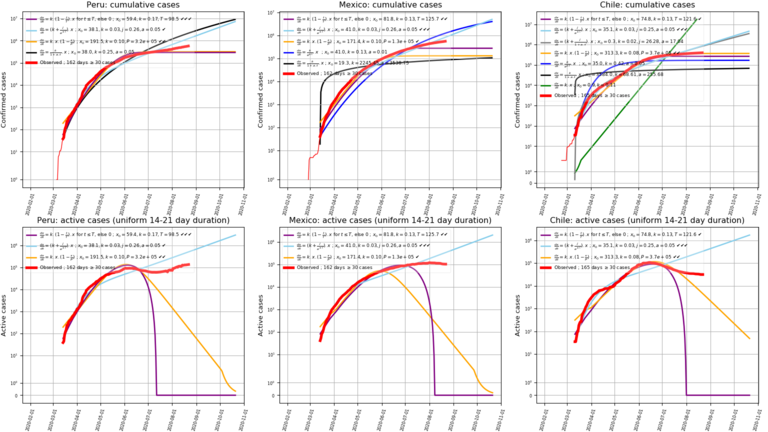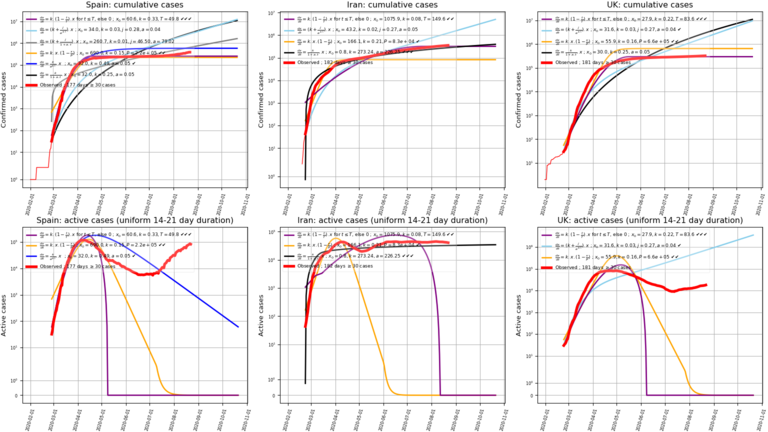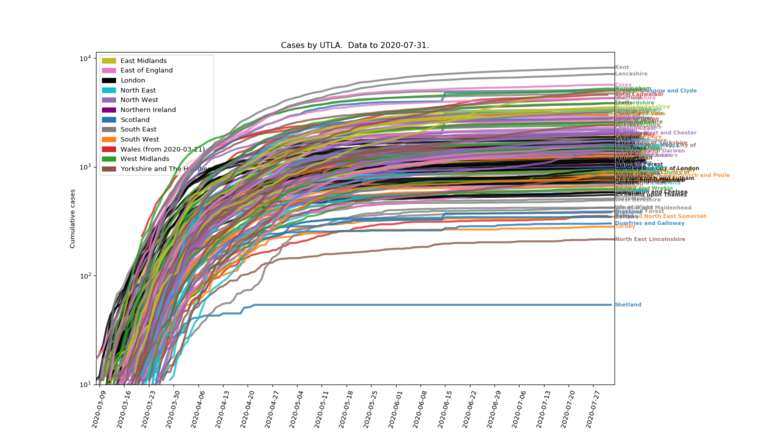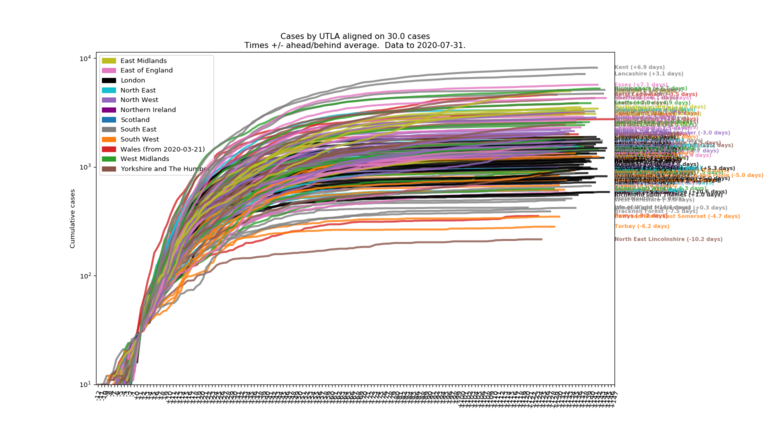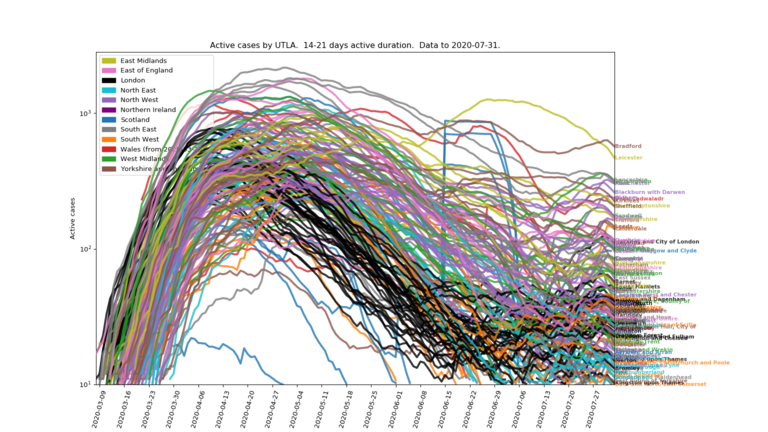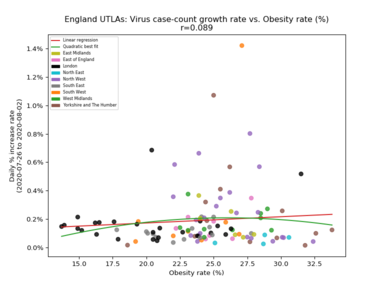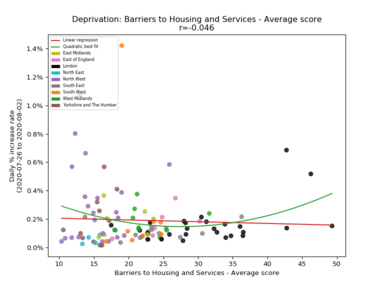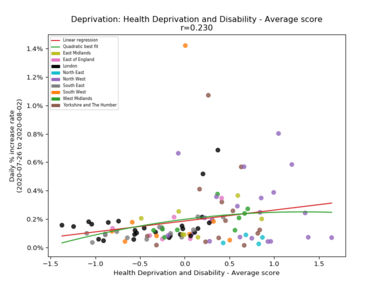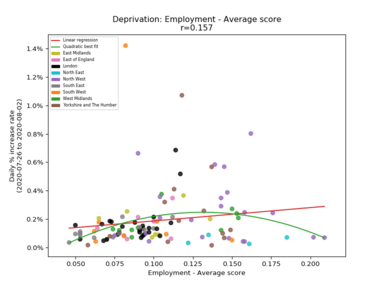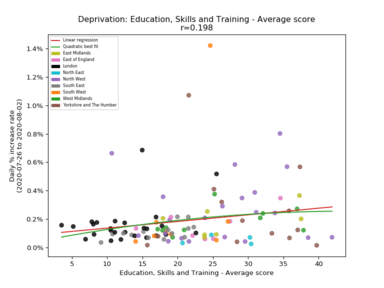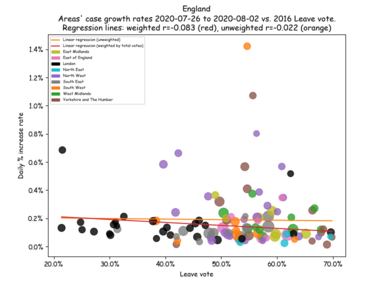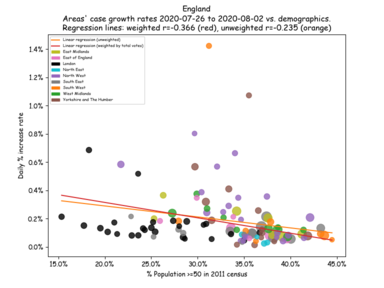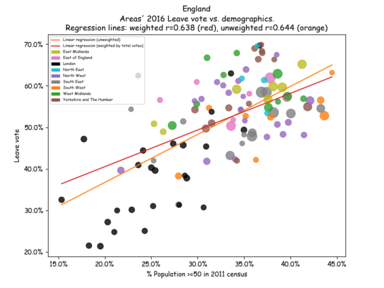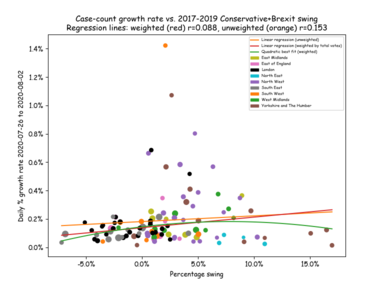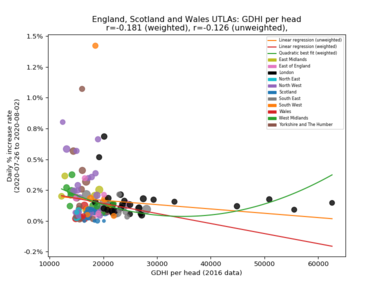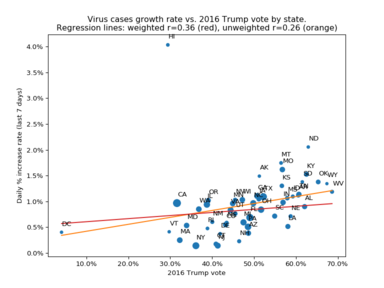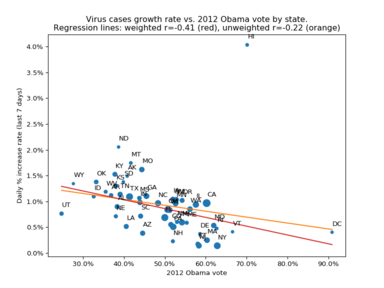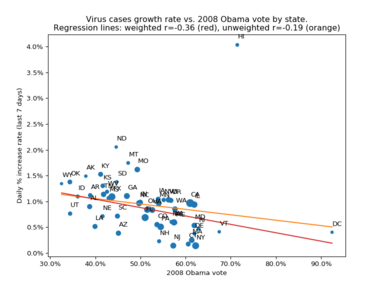coronavirus
#ArmchairEpidemiology
Some dubious charting with coronavirus data. Images can be clicked-through to full-resolution versions. Note that most (all?) the non-scatterplot charts are log-scale on the y-axis. Straight lines are actually exponential growth!
Sections on this page for global, UK and USA data, and some Links to much better pages than this one.
Code (Python, matplotlib) which generated these plots at https://github.com/timday/coronavirus.
Global
Plots created from the JHU tracker’s data (available at https://github.com/CSSEGISandData/COVID-19).
Cases
Case-count growth rates by country (China split Hubei/non-Hubei). Day-to-day increases plotted as points, with the lines showing growth over a 1-week window (this smooths out quite volatile daily rates and should remove any quirks of case reporting at weekends).
A couple of aligned plots of the cumulative case and death count curves.
“Active cases”, assuming a model where newly identified cases become “active” for 2-3 weeks (uniformly distributed; eventual outcome doesn’t matter). This is an alternative to using JHU’s “recovered” counts as there seems to be some doubt about how reliable they are in many countries.
And alternative views of the same “active cases” but plotting the number as a proportion of a country’s population (although splitting China between Hubei and all other provinces). Log and linear scale plots shown (the linear scale makes it clearer which countries are over the hump).
Projections
Some simple (and very naive) next two months projections of case-counts (and derived “active cases”) for the worst affected countries, simply by fitting (least squares) some simple models to the data so far. Models include straight exponential growth, variants with the growth rate decaying linearly or exponentially, with or without a constant floor, the logistic equation and linear decay to zero growth at a given time. In the chart legends there are 1-3 tick marks against the top 3 models best fitting the data. The best 3 models are also shown rendered as “active cases” (assuming each new case then has a uniform duration of 2-3 weeks of being “active” before it is resolved).
Note: Model parameters are constrained to only allow growth rates to fall, because it never occurred to me that they’d do anything else! So the best-fit “straight exponential growth” line (green) acts as an upper limit, and the variable-rate models can’t actually flex above it even if that was a better fit. Of course in practice, “case counts” must be at least as much a function of test and diagnostic capacity and policies as they are of any actual underlying growth of the disease itself.
UK
Data from the gov.uk tracker at https://coronavirus.data.gov.uk/ as curated into .csv file timeseries by https://github.com/tomwhite/covid-19-uk-data.
A messy plot of all the individual UTLAs/health-boards case counts:
Aligning all those on a constant number of cases:
The “active cases” assuming new cases are active for 2-3 weeks (uniform distribution):
Correlations
From the ONS, there is some UTLA-level data available (for England) for various health and deprivation metrics. Is there some correlation between these measures and the rate that virus case-counts are growing at?
Health
From the health data (from https://www.ons.gov.uk/peoplepopulationandcommunity/healthandsocialcare/healthinequalities/datasets/indicatorsoflifestylesandwidercharacteristicslinkedtohealthylifeexpectancyinengland, a 2017 release of 2015 data?), the score most correlated with the virus case-count growth rate appears to be the area’s obesity rate:
A snapshot of the correlations with all the various health metrics (using case-count growth rates over the week prior to the date shown, sorted by the magnitude of the latest figures):
Week to Week to Week to Week to Week to Week to Week to Week to
01/04/2020 08/04/2020 15/04/2020 22/04/2020 01/05/2020 15/5/2020 29/5/2020 13/06/2020
Smoking prevalence (%) : 0.230 0.318 0.211 0.110 0.135 0.103 0.151 0.266
Obesity rate (%) : 0.421 0.505 0.376 0.320 0.426 0.282 0.336 0.243
Preventable Mortality (deaths per 100,000) : 0.232 0.429 0.221 0.118 0.197 0.106 0.204 0.222
Adults eating 5-a-day (%) : -0.091 -0.145 0.000 0.156 0.101 0.152 0.006 -0.187
Alcohol-related admissions (per 100,000) : 0.221 0.470 0.304 0.250 0.347 0.270 0.290 0.155
Economically inactive (%) : 0.121 0.161 0.048 -0.065 0.045 -0.018 0.013 0.102
Employment rate (%) : -0.128 -0.157 -0.017 0.096 -0.043 -0.025 -0.002 -0.102
Unemployment rate (%) : 0.107 0.101 -0.060 -0.145 0.022 -0.031 -0.024 0.072
Physically active adults (%) : -0.272 -0.266 -0.120 -0.053 -0.113 -0.002 -0.072 -0.064
So - probably unsurprisingly - a general picture of unhealthy things being associated with faster case-count growth, and more health-positive things like physical activity, employment and even “5-a-day” being weakly linked with slower growth.
Deprivation
From the “deprivation index” data (from https://www.gov.uk/government/statistics/english-indices-of-deprivation-2019, the score most correlated with the virus case-count growth rate initially appeared to be “Education, Skills and Training” (higher score = worse!), but other deprivation indices have since taken over:
A snapshot of the correlations with all the various deprivation metrics (using case-count growth rates over the week prior to the date shown, sorted by the magnitude of the latest figures):
Week to Week to Week to Week to Week to Week to Week to Week to
01/04/2020 08/04/2020 15/04/2020 22/04/2020 01/05/2020 15/05/2020 29/05/2020 13/06/2020
Education, Skills and Training : 0.395 0.463 0.356 0.315 0.456 0.244 0.377 0.327
Barriers to Housing and Services : -0.332 -0.552 -0.455 -0.356 -0.449 -0.386 -0.358 -0.247
Health Deprivation and Disability : 0.282 0.512 0.297 0.203 0.324 0.166 0.282 0.199
Crime : 0.087 0.090 -0.023 -0.106 -0.094 -0.113 0.072 0.179
Employment : 0.300 0.498 0.236 0.186 0.295 0.144 0.242 0.167
IMD : 0.205 0.322 0.122 0.054 0.168 0.025 0.158 0.165
Income : 0.183 0.293 0.060 0.003 0.107 -0.013 0.119 0.133
IDACI : 0.162 0.242 0.036 -0.015 0.091 -0.030 0.103 0.103
Living Environment : -0.308 -0.256 -0.240 -0.269 -0.184 -0.239 -0.218 0.037
IDAOPI : -0.061 -0.073 -0.226 -0.284 -0.215 -0.233 -0.117 -0.008
(IMD - “Index of Multiple Deprivations”, an aggregate score; IDACI - “Income Deprivation Affecting Children Index”; IDAOPI - “Income Deprivation Affecting Older People Index”)
Note that while for most of these “deprivation index” numbers a higher score implies more deprivation, that appears to be reversed for the “Living Environment” score. I’m not sure of the interpretation of the “Barriers to Housing and Services” score either, but a high number seems to be frequently associated with wealthy (and therefore unaffordable) areas.
Brexit and demographics
Plotting case-count growth against the 2016 Leave vote also shows some correlation:
Reminder: correlation is not causation! And calling COVID-19 “The Brexit Disease” or “Leave Fever” would just be silly.
Initially, plotting case-count growth against demographics from the 2011 census showed very little correlation, but it seems to have become more correlated over the weeks I’ve been plotting this:
There is actually a rather large correlation between the same demographic measure and the Leave vote (so the initial lack of correlation was quite surprising).
Elections
Unsurprisingly, given the previous section’s results, the highest correlation I can find with 2017-2018 election data (England only) is the swing from the Conservative+UKIP vote share in 2017 to the Conservative+Brexit party vote share in 2019:
Income
Finally, case-count growth rate vs. GDHI (“gross disposable household income per head”)
Money is quite an effective anti-viral it seems.
USA
A plot of coronavirus cases growth rate over the last week (JHU’s data again) vs. each state’s 2016 Trump vote (sized/weighted by total vote).
Unsurprisingly, the chart is pretty much flipped left-right for the 2012 & 2008 Obama votes.
Not particularly interesting trend-lines; there was more of a slant to them in the early days but that might just have been regional timing of the initial growth surges. California and Texas possibly dominate the weighted regression line.
Links
- If you’re not running the Covid-19 Symptom Tracker app… why not? https://covid.joinzoe.com/.
- Updates and webinars by the team behind this app at https://covid.joinzoe.com/blog.
- App now also available for the USA at https://covid.joinzoe.com/us.
- The FT is doing some interesting charting: https://www.ft.com/coronavirus-latest.
- But Information Is Beautiful has the best looking: https://informationisbeautiful.net/visualizations/covid-19-coronavirus-infographic-datapack/
- Various “dashboard” pages:
- Interesting read on why pandemic modelling is hard: https://fivethirtyeight.com/features/why-its-so-freaking-hard-to-make-a-good-covid-19-model/
- …and another one on all the problems with case-counts: https://fivethirtyeight.com/features/coronavirus-case-counts-are-meaningless/
